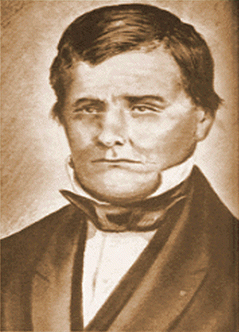William B. Waddell (Pony Express founder) facts for kids
Quick facts for kids
William Bradford Waddell
|
|
|---|---|
 |
|
| Born | October 17, 1807 |
| Died | April 1, 1872 (aged 64) |
William Bradford Waddell (1807–1872) was an important American businessman. He is best known as one of the three founders of the famous Pony Express. Along with his partners, Alexander Majors and William Hepburn Russell, he helped create this fast mail delivery service. People described Waddell as a careful and thoughtful person. He was known for being very cautious with money and taking his time to make big decisions.
Early Life and First Steps
William Bradford Waddell was born on October 17, 1807. His family lived in Fauquier County, Virginia. In 1811, when William was young, his family moved to Mason County, Kentucky. This area was a busy place where many new people were settling.
When he was 17, in 1824, William left home to find work. He first worked in lead mines in Galena, Illinois. After that, he moved to St. Louis, Missouri. There, he worked as a clerk in a dry goods store. A dry goods store sells things like fabric, clothing, and other household items.
Soon after, he went back to Kentucky. On January 1, 1829, he married Susan Byram. They tried farming, but William did not enjoy it. So, he decided to open his own dry goods store. This store in Mays Lick, Kentucky was very successful.
Starting New Businesses
In 1835, Waddell moved his family again. This time, they settled in Lexington, Missouri. He opened another dry goods store right by the waterfront. This was a good spot for business.
A few years later, in 1837, Waddell teamed up with William Hepburn Russell. Together, they started several new companies. These included a land development company and an insurance company. He also helped build a school for girls. Waddell also built a brick store and a large warehouse for hemp. Hemp was an important crop in the area.
Waddell first got into the freighting business with Russell. Freighting means moving goods from one place to another. In 1853, they formed a company called Waddell & Russell. This company bought and sold goods in large amounts. Later that year, they used wagon trains to carry military supplies. They delivered these supplies to forts in Kansas and New Mexico.
The Famous Pony Express
Waddell and Russell decided to bring in a new partner. This new partner was Alexander Majors. On January 1, 1855, their new company was formed. It was called Russell, Majors and Waddell. This company became very big. They won a major contract with the United States War Department. This meant they would supply most of the military forts west of the Missouri River.
Later, the company started a stagecoach business. It was called the Central Overland California and Pikes Peak Express Company. They hoped to get a contract to deliver mail from Missouri to California. In 1860, this company launched a very special mail service. It was called the Pony Express.
The Pony Express began on April 3, 1860. It was known for its fast horse riders who carried mail across the country. William Waddell managed the business side of things. He worked from the company's main office in Lexington, Missouri. Later, the office moved to Leavenworth, Kansas.
However, the Pony Express did not make money. It was losing a lot of money every day. By October 1861, the Pony Express stopped running. This happened because new telegraph lines were completed. The telegraph could send messages much faster than a horse. Also, the government decided not to give the company more money.
Later Years
After the Pony Express closed in 1861, William Waddell retired. He never started another business. He moved back to his home in Lexington, Missouri. In 1869, he bought the Waddell House.
However, his later years were not easy. The American Civil War greatly affected his family. He also faced difficulties with taxes and debts. Because of these problems, he had to sell his land. William Waddell passed away on April 1, 1872. He was 65 years old. He died at his daughter's home in Lexington, Missouri, where he is also buried.

